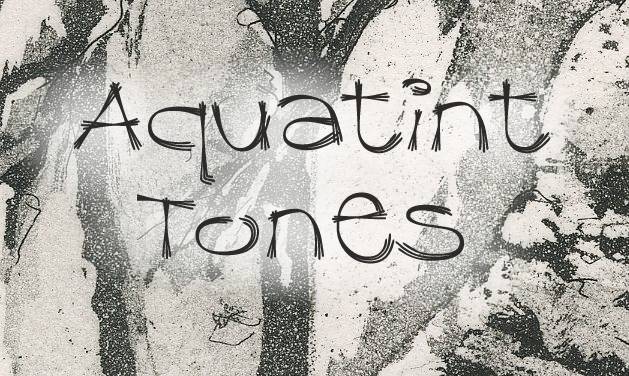When used in etching aquatint is a way of achieving subtle changes in tone from very light to deeply dark. Tone is created using texture and the texture can be so fine you can hardly see it, fairly subtle or very grainy.
Aquatint is often used exclusively on a printing plate and you have to start with it if you will go on to adding other methods. Usually, the artist will only go on to add more after the aquatint is removed if a strong dark accent is shown to be needed by the first printed proof.
I love the softness of aquatint and have used it on many of my original prints.
Once again I must emphasise that this is not a lesson to learn how to make an aquatint. The lovely people who buy my original prints are intrigued and fascinated by them and want to know more about the process. Long conversations ensue and can become exhausting to both the listening art lover and myself.
It can be hard to gauge just how much information a person wants. Are they thinking …
“Lor’ what have I let myself in for!!!”
… as I launch into all the details?
So What is Aquatint and How is it Done?
This is where grains of powdered resin are melted onto the metal plate leaving gaps where the acid can bite.
Resin powder is dangerous to the health and must not be breathed in so a special big agitating box is needed. I believe there are modern boxes that work differently but this is about the ones I have used. I had to dress up in overalls and wear a breathing mask in case of escaping resin powder.
Resin powder is put on a sort of paddle and you crank a handle whirling it around until it is suspended in the air in tiny particles. The pristine metal plate is placed in the box to catch the settling dust.
An even coating is needed and the effect will vary according to how the fine the powder is when suspended in the air and how much of it settles on the plate. Timing is important so you can’t go off and have a leisurely lunch.
The plate is removed from the chamber and placed on a hot plate taking care not to disturb the dust. The heats melts the resin until it is firmly stuck to the metal.
To Make the Image
An acid resistant liquid is painted on to keep areas protected from the acid. The ‘resist’ is allowed to dry and the plate is dipped in the acid. This is done progressively. The areas to be kept the lightest are painted first and any parts to be kept completely white must be done before the first dip.
Even complex designs can be made with one immersion. However, areas can be painted over with resistant stuff and the plate dipped in the acid again to allow it to eat a deeper recess making it darker. This is usually done multiple times to achieve the desired result.
Every time the plate is immersed it must be carefully cleaned before adding the next area of ‘resist’. The resist has to be completely dry before the next dip.
As the work progresses more and more of the plate is covered with black stuff and it becomes really hard to see where you are. It requires great concentration.
I suppose other artists are super-efficient and keep a clever reference to work by. I know I was too eager – or impatient – with my small ones and dived right in with a scant sketch by my side. I couldn’t do a big one that way – it takes too long and I be lost if I came back to it a week later, I should think. I confess I have one such abandoned plate in the drawer. One day I will tackle it – perhaps.
Back to the process of aquatint.
Once the artist is satisfied that sufficient dippings and coverings have taken place all the resist and the aquatint resin must be removed. Care must be taken not to scratch the surface of the metal and the plate must be squeaky clean before taking that mysterious and surprising first proof.
At this point the suspense is killing me!
I leave the subject of printing the etching plate to another article. I’ll link to it when done – do please come back and read it when you find time.

